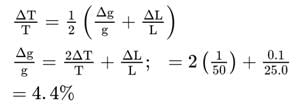Test: Measurement & Error Analysis - NEET MCQ
10 Questions MCQ Test Physics Class 11 - Test: Measurement & Error Analysis
The accuracy in the measurement of time for 20 oscillations of pendulum for the following measurements, t1 = 39.6 s, t2 = 39.9 s and t3 = 39.5 s is:
Which of the following is caused by careless handling?
A student measures the distance covered and time taken by a body under free fall which was initially at rest. He uses this data for estimating g, the acceleration due to gravity. If the maximum percentage error in measurement of the distance and the time are e1 and e2 respectively, then the maximum possible percentage error in the estimation of g is:
Error in the measurement of radius of a sphere is 1%. The error in the calculated value of its volume is:
The error in two readings of A are 0.01 and -0.03, then mean absolute error is?
At a certain place, the acceleration due to gravity is determined using a simple pendulum. The length of the pendulum is 25.0 cm and a stopwatch with least count is 1 s measures the time taken by the pendulum for 40 oscilations to be 50 s. the accuracy in the measurement of g is:
The most suitable instrument for measuring the size of an atom is:
The method used to measure the distance of a planet from the earth is:
What is the percentage error in the physical quantity A if it is related to four other physical quantities a, b, c and d as  The percentage error in measurement of a, b, c and d are 1%, 3%, 2% and 2% respectively.
The percentage error in measurement of a, b, c and d are 1%, 3%, 2% and 2% respectively.
|
97 videos|379 docs|103 tests
|





























